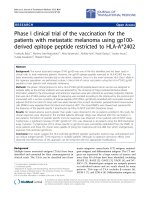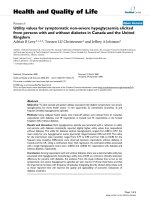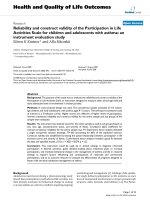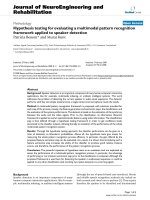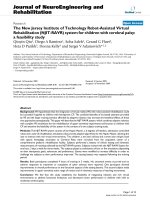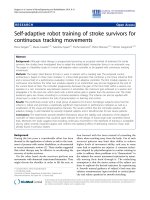Báo cáo hóa học: " Track-before-detect procedures for detection of extended object" potx
Bạn đang xem bản rút gọn của tài liệu. Xem và tải ngay bản đầy đủ của tài liệu tại đây (370.2 KB, 6 trang )
RESEA R C H Open Access
Track-before-detect procedures for detection of
extended object
Ling Fan
*
, Xiaoling Zhang and Jun Shi
Abstract
In this article, we present a particle filter (PF)-based track-before-detect (PF TBD) procedure for detection of
extended objects whose shape is modeled by an ellipse. By incorporating of an existence variable and the target
shape parameters into the state vector, the proposed algorithm performs joint estimation of the target presence/
absence, trajectory and shape parameters under unknown nuisance parameters (target power and noise variance).
Simulation results show that the proposed algorithm has good detection and tracking capabilities for extended
objects.
Keywords: extended targets, track-before-detect, particle filter, signal-to-noise ratio
Introduction
Most target tracking algorithmsassumeasinglepoint
positional measurement corresponding to a target at
each scan. However, high resolution sensors are able to
supply the measurements of target extent in one or
more dimensions. For example, a high-resolution radar
prov ides a useful measure of down-range extent given a
reasonable signal-to-noise ratio (SNR). The possibilit y to
additionally make use of the high-resolution measure-
ments is referred as extended object tracking [1]. Estima-
tion of the object shape parameters is especially
important for track maintenance [2] and for the object
type classification.
More recent approaches to tracking extended targets
have been investigated by assuming that the measure-
ments of target extent are available [1-5]. However, the
measurements of extended targets provided by the high
resolution sensor are inaccurate in a low SNR environ-
ment since those are obtained by threshold-based deci-
sions made on the raw measurement at each scan. Ristic
et al. [3] investigated the influence of extent measure-
ment accuracy on the estimation a ccuracy of target
shape parameters, and demonstrated that the estimation
of target shape parameters is unbelievable when the
measurement of extended targets is not available. An
alternative approach, referred as track-before-detect
(TBD), consists of using raw, unthresholded sensor data.
TBD-based procedures jointly process several consecu-
tive scans and, relying on a target kinematics, jointly
declare t he presence of a target and, eventua lly, its
track, and show superior detection performance over
the conventional methods. In previously developed TBD
algorithms, the target is assumed to be a point target
[6-18]. Recently extension of TBD method for tracking
extended targets has been considered in [19], by model-
ing the target extent as a spatial probability distribution.
In this study, an ellipsoidal model of target shape pro-
posed in [1-3] is adopted. The elliptical model is conve-
nient as down-range and cross-range extent vary
smoothly with orientation relative to the line-of-sight
(LOS ) between the observer and the target. The consid-
ered problem consists of both detection and estimation
of state and size parameters of an extended target in the
TBD framework. By incorporating of a binary target
existence variable and the target shape parameters into
the state vector, we have proposed a particle filter (PF)-
based TBD (PF TBD) method for joint detection and
estimation of an extended target state and size para-
meters. The proposed method is investigated under
unknown nuisance parameters (target power and noise
variance). The detection and tracking performances
of the proposed algorithm are studied with respect to
different system settings.
The art icle is organized as foll ows. ‘ Target and
measurement models’ section introduces target and
* Correspondence:
School of Electronic Engineering, University of Electronic Science and
Technology of China, Cheng du, China
Fan et al. EURASIP Journal on Advances in Signal Processing 2011, 2011:35
/>© 2011 Fan et al; licensee Springer. This is an Open Access article distributed under the terms of the Creative Commons Attribution
License ( enses/by/2.0), which permits unrestricted use, distribution, and reproduction in any medium,
provided the origin al work is properly cited.
measurement models. The PF TBD algorithm is pre-
sented under unknown nuisance parameters (target
power and noise variance) in ‘PF TBD procedures’ sec-
tion. The performance assessment of the proposed
algorithm is the object of ‘Simulation and results’ sec-
tion. ‘ Conclusion’ section contains some concluding
remarks.
Target and measurement models
Extended target model and state dynamics
In this article, we are concerned with an extended object
moving on the x-y plane, whose shape can be modeled
by an ellipse. Figure 1 illustrates a typical scenario of
interest. Similarly to [2], we assume that the ratio of
minor and major axes of the ellipse is fixed and known
for the targets of interest to simplify the exposition.
Thus, only the single parameter of target length ℓ is
required. Our goal is to estimate the joint kinematic-fea-
ture state vector:
x
k
=[x
˙
xy
˙
y ]
T
k
, where [xy]
k
and
[
˙
x
˙
y]
k
denote position and velocity of the centre of an
extended target, respectively; ℓ
k
denotes the target
length. We assume that the target centroid moves
according to a constant velocity model:
x
k
=
⎡
⎢
⎢
⎢
⎢
⎣
1 T 000
01000
001T 0
00010
00001
⎤
⎥
⎥
⎥
⎥
⎦
x
k−1
+
⎡
⎢
⎢
⎢
⎢
⎣
T
2
20 0
T 00
0 T
2
20
00T
00T
⎤
⎥
⎥
⎥
⎥
⎦
v
k
(1)
where ΔT is the t ime interval between successiv e
scans and v
k
is a zero-mean Gaussian noise vector with
covariance cov[v
k
]=Q =diag(q
x
, q
y
, q
ℓ
), where q
x
and
q
y
are the usual acceleration noise variances for the con-
stant velocity model. A small, non-zero value for q
ℓ
allows for some adjustment of the target length
estimate.
The target down-range extent L(j(x )) is given by
(omitting the frame subscript k)
L(φ(x)) =
cos φ(x)
(2)
where j(x) is the angle between the major axis of the
ellipse and the target-observer LOS. If t he target ellipse
is oriented so that its major axis is parallel to its velocity
vector then the down-range target extent L(j(x)) can be
written as
cos φ(x)=
pos, vel
pos
·
vel
=
x
˙
x + y
˙
y
x
2
+ y
2
˙
x
2
+
˙
y
2
(3)
Thus, L(j(x)) depends only on the target length ℓ and
its orientation with respect to the LOS.
Furthermore, to indicate the presence or absence of a
target, the random variable modeled by a two-state Mar-
kov chain, i.e., E
k
Î {0,1}, is used [14-16], where E
k
=1
means the target is present and E
k
=0meansthetarget
is absent. The Markov transition matrix is defined as
=
1 − P
b
P
b
P
d
1 − P
d
(4)
P
b
=Pr{E
k
=1|E
k-1
= 0} is the probability of transi-
tion from absent to present, i.e., ‘birth of the target’, and
P
d
=Pr{E
k
=0|E
k-1
= 1} is the probability of transition
from present to absent, i.e., ‘death of the target’.
Measurement model
The measurements are the reflected power on range-
azimuth domain. The range and azimuth domains are
divided into N
r
and N
a
cells, respectively. The resolu-
tions of range and azimuth are Δ
r
and Δ
a
.LetΩ ≡
{1, , N
r
}andS ≡ {1, , N
a
-1}denotethesetofreso-
lution cell in range and azimuth domain, respectively.
According to ‘ Extended target model and state
dynamics’ subsection, the set of range cell containing
useful target echoes can be expressed as
T
=
r
k
−
L
(
φ
(
x
k
))
2
r
, ,
r
k
r
, ,
r
k
−
L
(
φ
(
x
k
))
2
r
(5)
()
L
I
I
t
a
rg
e
t
v
e
l
o
c
i
t
y
v
e
c
t
o
r
a
c
t
u
a
l
l
e
n
g
t
h
(, )
x
y
T
x
"
Figure 1 Illustration of the observer-extended target geometry.
Fan et al. EURASIP Journal on Advances in Signal Processing 2011, 2011:35
/>Page 2 of 6
where
r
k
=
x
2
k
+ y
2
k
and ⌈X⌉ rounds the elements of X
to the nearest integers towards infinity. Let
m
1
=
r
k
−
L(φ(x
k
))
2
r
, , m
R
=
r
k
+
L(φ(x
k
))
2
r
,
where
R =
L(φ(x
k
))
r
is the t otal number of the range
cell occupied by the down-range target extent, depend-
ing on the target state, target length, and the range reso-
lution. Thus, Ω
T
={m
1
, , m
R
} Î Ω.Theazimuthcell
containing target echoes is
n
T
= arctan
y
k
x
k
. At each
scan k,thepowermeasurement
z
k
=
z
(m,n)
k
, m ∈ ; n ∈ S
is given by
z
(
m,n
)
k
= w
(
m,n
)
k
, m ∈ ; n ∈ SE
k
=
0
(6)
z
(m,n)
k
= P
(m,n)
k
+ w
(m,n)
k
, m ∈
T
, n = n
T
z
(m,n)
k
= w
(m,n)
k
, m ∈ \
T
, n ∈ S
E
k
=
1
(7)
where Ω/Ω
T
denotes the difference between Ω and
Ω
T
.
w
(
m,n
)
k
is an exponential distribution noise with
variance s
2
.
P
(m,n
)
k
is the unknown target p ower
inonerangecell.TheSNRisdefinedas
S
NR =
m∈
T
P
(m,n
T
)
k
σ
2
.Notethatthismeasurement
is highly nonlinear with the target state.
Each pixel
z
(m,n)
k
follows an exponential distribution
p(z
(m,n)
k
|μ
k
, E
k
=0)=
1
σ
2
exp(−
z
(m,n)
k
σ
2
)
(8)
if only no is e exists or a non-central chi-square distri-
bution with two degrees of freedom
p(z
(m,n)
k
|μ
k
, E
k
=1)=
1
σ
2
exp
−
z
(m,n)
k
+ P
(m,n)
k
σ
2
I
0
⎛
⎜
⎝
2
z
(m,n)
k
P
(m,n)
k
σ
2
⎞
⎟
⎠
(9)
if the cell containing target echoes, where I
0
is the
zero-order modified Bessel function; μ
k
= s
2
when E
k
=
0and
μ
k
=(σ
2
, P
(m,n)
k
)
when E
k
=1,denotesthenui-
sance parameters. Assuming th at all the pixels of z
k
are
independent, the likelihood function of z
k
is given by
p(z
k
|µ
k
, E
k
=0)=
m∈
,
n∈S
p(z
(
m,n
)
k
|μ
k
, E
k
=0
)
(10)
if no target exists or
p(z
k
|x
k
, µ
k
, E
k
=1)=
m∈
T
,n=n
T
p(z
(m,n)
k
|μ
k
, E
k
=1)
m∈
\
T
,n∈S
p(z
(m,n)
k
|μ
k
, E
k
=0
)
(11)
if the target is present, where
µ
k
=(σ
2
, P
(m
1
,n
T
)
k
, , P
(m
R
,n
T
)
k
)
when E
k
= 1. The likelihood ratio can be written as
L(z
k
|x
k
, µ
k
, E
k
=1)=
p(z
k
|x
k
, µ
k
, E
k
=1)
p(z
k
|µ
k
, E
k
=0)
=
m∈
T
,n=n
T
exp
−
P
(m,n)
k
σ
2
I
0
⎛
⎜
⎝
2
z
(m,n)
k
P
(m,n)
k
σ
2
⎞
⎟
⎠
(12)
L
(
z
k
|µ
k
, E
k
=0
)
=1
.
(13)
PF TBD procedures
From a Bayesian perspective, a complete solution of the
above problem is that given the set of unthresholded
range-azimuth data maps up to the k th scan, Z
k
=(z
1
, ,
z
k
) and prior PDF p
birth
(x
k
), determines the posterior PDF
p(x
k
, E
k
|Z
k
). Due to the highly nonlinear relationship cou-
ples the measurement with the target state we resort to PF
TBD procedures. The algorithm outlined here is similar to
the work of [15,16] but the target state is augmented by
the target length ℓ and does not include the unknown tar-
get power. The reason is that the unknown target power is
a variable based on the point target assumption in [15,16].
However, as we discu ssed in ‘Target and measurement
models’ section, the extended target echoes occupy the
multi range cells depending on the down-range extent and
the range resolution (recall Equation 5). Thus, not only
the unknown target power
P
(m
1
,n
T
)
k
, , P
(m
R
,n
T
)
k
is variable
but also the number of unknown target power R is vari-
able. It is difficult to use the PF to estimate them simulta-
neously. Therefore, we consider maximum likelihood
(ML) estimates of the unknown nuisance parameters
µ
k
=(σ
2
, P
(
m
1
,n
T
)
k
, , P
(
m
R
,n
T
)
k
)
. We first give an algorithm
description of the PF TBD.
At k-1 th time step, given the hybrid state of the parti-
cles
(
x
k−1
, E
k−1
)
i
,1
N
N
i
=
1
,thePFTBDalgorithmis
given as follows:
(1) Generate the new hybrid state (x
k
, E
k
)
i
, i =1, ,N:
(a) Generate the new existence variable
E
i
k
N
i
=
1
on the basis of
E
i
k−1
N
i
=
1
and
E
i
k
N
i=1
∼ MT
Markov
E
i
k−1
N
i=1
,
(b) Generate the new target state
{
x
k
}
N
i
=
1
:
x
i
k
∼ p(x
k
|x
i
k
−1
)ifE
i
k
−1
=1,E
i
k
=
1
x
i
k
∼ p
birth
(x
k
)ifE
i
k
−1
=0,E
i
k
=
1
(2) Calculate the weights:
˜
w
i
k
= L(z
k
|x
i
k
, µ
k
, E
k
=1) if E
i
k
=
1
˜
w
i
k
=1 if E
i
k
=
0
(3) Normalize the weights:
w
i
k
=
˜
w
i
k
N
i=1
˜
w
i
k
, i =1, ,
N
Fan et al. EURASIP Journal on Advances in Signal Processing 2011, 2011:35
/>Page 3 of 6
(4) Resample:
(
x
k
, E
k
)
i
, w
i
k
N
i
=1
→
(
x
k
, E
k
)
i
∗
,1
N
N
i
=
1
(5) Calculate the p robability of the target existence
and the MMSE estimate of the target state:
ˆ
P
e,k
=
N
i=1
E
i
k
N,
ˆ
x
k
=
N
i=1
x
i
k
E
i
k
N
i=1
E
i
k
For the unknown nuisance parameters μ
k
,weassume
they as an unknown deterministic parameters and derive
ML estimates. The logarithm of the likelihood function
can be written as
ln p(z
k
|x
k
, µ
k
, E
k
=1)=−M ln σ
2
−
U
k
+
m∈
T
P
(m,n
T
)
k
σ
2
+
m∈
T
ln
⎛
⎜
⎝
I
0
⎛
⎜
⎝
2
z
(m,n
T
)
k
P
(m,n
T
)
k
σ
2
⎞
⎟
⎠
⎞
⎟
⎠
(14)
Where M = N
r
N
a
is the total number of the range-
azimuth cells;
U
k
=
m∈
,
n∈S
z
(
m,n
)
k
is the summation of
all pixels; Ω
T
is the range cells occupied by the down-
range target extent; n
T
is the azimuth cell occupied by
the target. We evaluate the partial derivatives of the
logarithm likelihood function as
∂ ln p(z
k
|x
k
, µ
k
, E
k
=1)
∂P
(m
1
,n
T
)
k
= −
1
σ
2
+
I
1
(2
z
(m
1
,n
T
)
k
P
(m
1
,n
T
)
k
σ
2
)
I
0
(2
z
(m
1
,n
T
)
k
P
(m
1
,n
T
)
k
σ
2
)
1
σ
2
z
(m
1
,n
T
)
k
P
(m
1
,n
T
)
k
(15)
∂ ln p(z
k
|x
k
, µ
k
, E
k
=1)
∂P
(m
R
,n
T
)
k
= −
1
σ
2
+
I
1
(2
z
(m
R
,n
T
)
k
P
(m
R
,n
T
)
k
σ
2
)
I
0
(2
z
(m
R
,n
T
)
k
P
(m
R
,n
T
)
k
σ
2
)
1
σ
2
z
(m
R
,n
T
)
k
P
(m
R
,n
T
)
k
(16)
∂ lnp(z
k
|x
k
, µ
k
, E
k
=1)
∂σ
2
= −M
1
σ
2
+
U
k
+
m∈
T
P
(m,n
T
)
k
σ
2
2
−
m∈
T
I
1
(2
z
(m,n
T
)
k
P
(m,n
T
)
k
σ
2
)
I
0
(2
z
(m,n
T
)
k
P
(m,n
T
)
k
σ
2
)
2
z
(m,n
T
)
k
P
(m,n
T
)
k
σ
2
2
(17)
where
I
1
(·)=I
0
(·
)
is the first-order modified Bessel
Function. Equating (15) and (16) to zero, we obtain
I
1
(2
z
(m
1
,n
T
)
k
ˆ
P
(m
1
,n
T
)
k
ˆσ
2
)
I
0
(2
z
(m
1
,n
T
)
k
ˆ
P
(m
1
,n
T
)
k
ˆσ
2
)
=
ˆ
P
(m
1
,n
T
)
k
z
(m
1
,n
T
)
k
(18)
I
1
(2
z
(m
R
,n
T
)
k
ˆ
P
(m
R
,n
T
)
k
ˆσ
2
)
I
0
(2
z
(m
R
,n
T
)
k
ˆ
P
(m
R
,n
T
)
k
ˆσ
2
)
=
ˆ
P
(m
R
,n
T
)
k
z
(m
R
,n
T
)
k
(19)
Substitut ing (18) and (19) into (17), and equating (17)
to zero, we obtain
m
R
m=m
1
ˆ
P
(m,n
T
)
k
= U
k
− M ˆσ
2
(20)
By solving equation (18) to (20) jointly, we can
find the ML estimates of the unknown parameters
ˆµ
k
=(ˆσ
2
,
ˆ
P
(
m
1
,n
)
k
, ,
ˆ
P
(
m
R
,n
)
k
)
.
Simulation and results
In our simul ation, the radar is located at the origin and
the system parameter is ΔT =0.1s,Δ
a
=1°,Δ
r
=5m,
N
r
= 3000, and N
a
= 60. The total number of scan simu-
lated is 30, and a target appears at scan k = 6 at initial
location [9520 9040] m with a constant velocity of [-507
-390] m/s towards the radar and disappears at scan k =
21. The target length is ℓ = 20 m and the target may
occupy as much as four range cells depending on its
orientation. The acceleration noise variances were set to
q
x
= q
y
=1,q
ℓ
=10
-2
. Figure 2 shows the target trajec-
tory in x-y plane.
The filter parameters are used as follow. The number
of part icles is N = 8000. The prior PDF p
birth
(x
k
)is
assumed as uniform distribution: [x, y]~U[8000,
10000],
[
˙
x,
˙
y]
∼ U
[
−640, 0
]
,andℓ ~U[0, 60]. The prob-
ability of birth and death required by the Markov transi-
tion matrix are p
b
= p
d
= 0.1.
The average probabilities of targ et existence of the pro-
posed algorithm with respect to different SNR are plotted
in Figure 3. For each SNR, the target present is declared
if the probability of existence is higher than where there
is only noise. Figure 3 demonstrates that the proposed
algorithm detect the extended targets with an average
SNR as low as 3 dB, on average. However, it can be seen
from Figure 3 that the more SNR is low, the more the
detection delay is serious. For example, the target present
is declared immediately at k = 6 for SNR = 12 dB, but for
SNR = 3 the target present is declared till k =11.Itis
means that the detection delay is 5 scans when SNR
declines from 12 to 3 dB. Due to TBD-based procedures
integrate all information over time, k ≥ 6frameshad
been used to jointly process for the batch methods like
dynamic programming based TBD (or Viterb i-like TBD)
[6-8], the detection delay for the recursive method like
8600 8700 8800 8900 9000 9100 9200 9300 9400 9500 960
0
8000
8200
8400
8600
8800
9000
9200
9400
x
(
m
)
y(m)
position of the centre of an extended target
true length of target
Figure 2 Target trajectory in x-y plane.
Fan et al. EURASIP Journal on Advances in Signal Processing 2011, 2011:35
/>Page 4 of 6
PF TBD, therefore, reflects that frames are needed to
detect the targets for different SNR.
Figures 4 and 5 show the tracking performance in
terms of root mean square error (RMSE) in position
and length, respectively. The position RMSE was calcu-
lated according to
p
osition RMSE
k
=
1
I
I
i=1
((x
k
−
ˆ
x
i,k
)
2
+(y
k
−
ˆ
y
i,k
)
2
)
(21)
where x
k
and y
k
are the true target position at time k,
ˆ
x
i
,k
, and
ˆ
y
i
,
k
are the estimated target position at time k of
simulation I and I is the number of Monte-Carlo simu-
lations. The length RMSE is given similarly:
length RMSE
k
=
1
I
I
i=1
(
k
−
ˆ
i,k
)
2
.
(22)
It is shown that consistent estimates of the target
position and length are calculated by the filter, with
higher SNR providing better position and length esti-
mates in Figures 4 and 5. However , considering the
resolution of range is Δ
r
= 5 m, the position RMSE is
greater than one resolution cell of range even for SNR =
12 dB. The reason is that estimation of the target posi-
tion is the position of the centre of the extended target
(see ‘Extended target model and state dynamics’ subsec-
tion), while the length of target is unknown and needs
to be estimated.
Conclusions
In this article, we have investigated the PF TBD proce-
dures for detection of the extended targets whose shape
is modeled aby an ellipse. An existence variable is incor-
porated into the state vector to determine the presence
of an extended target in the data. The target shape para-
meters are also included in the state vector to be esti-
mated. Due to the highly nonlinear relationship couples
the measurements of target extent with the target state,
we have proposed a PF TBD method for joint estima-
tion of the target presence/absence, trajectory, and
length under unknown nuisance parameters (target
power and noise variance). Simulation results show that
the proposed algorithm has good detection and tracking
capabilities for the extended targets even for low SNR,
i.e., 3 dB.
List of abbreviations
LOS: line-of-sight; ML: maximum likelihood; PF: particle filter; PF TBD: particle
filter-based track-before-detect; RMSE: root mean square error; SNR: signal-to-
noise ratio; TBD: track-before-detect.
Acknowledegments
This work was supported by the Aero Science Foundation of China, Project
20090180001
0 0.5 1.0 1.5 2.0 2.5 3.
0
0
0.1
0.2
0.3
0.4
0.5
0.6
0.7
0.8
0.9
1
Times (s)
Probability of existence
12dB
6dB
3dB
noise
Figure 3 Average probability of existence over 100 simulations.
0 0.5 1.0 1.5 2.0 2.5 3.0
0
5
10
15
20
25
30
35
40
45
50
55
60
Times (s)
RMSE-position (m)
12dB
6dB
3dB
Figure 4 Average error in position over 100 simulations.
0 0.5 1.0 1.5 2.0 2.5 3.0
2
3
4
5
6
7
8
Times (s)
RMSE-length (m)
12dB
6dB
3dB
Figure 5 Average error in length over 100 simulations.
Fan et al. EURASIP Journal on Advances in Signal Processing 2011, 2011:35
/>Page 5 of 6
Competing interests
The authors declare that they have no competing interests.
Received: 19 October 2010 Accepted: 4 August 2011
Published: 4 August 2011
References
1. D Angelova, L Mihaylova, Extended object tracking using Monte Carlo
methods. IEEE Trans Signal Process. 56(2), 825–832 (2008)
2. D Salmond, M Parr, Track maintenance using measurements of target
extent. IEE Proc Radar Sonar Navig. 150(6), 389–395 (2003). doi:10.1049/ip-
rsn:20030933
3. B Ristic, D Salmond, A study of a nonlinear filtering problem for tracking an
extended target, in Proceedings of 7th International Conference on
Information Fusion, 503–509 (2004)
4. K Gilholm, D Salmond, Spatial distribution model for tracking extended
objects. IEE Proc Radar Sonar Navig. 152(5), 364–371 (2005). doi:10.1049/ip-
rsn:20045114
5. D Salmond, N Gordon, Group and extended object tracking. Proc SPIE.
3809 (1999)
6. Y Barniv, Dynamic programming solution for detecting dim moving targets.
IEEE Trans Aerosp Electron Syst. 21, 144–156 (1985)
7. SC Pohlig, An algorithm for detection of moving optical targets. IEEE Trans
Aerosp Electron Syst. 25(1), 56–63 (1989). doi:10.1109/7.18661
8. BD Carlson, ED Evans, SL Wilson, Search radar detection and track with the
Hough Transform, Part I: system concept. IEEE Trans Aerosp Electron Syst.
30(1), 102–108 (1994). doi:10.1109/7.250410
9. WR Wallace, The use of track-before-detect in pulse-Doppler radar, in
Proceedings of International Conference on Radar, 315–319 (2002)
10. LA Johnstom, V Krishnamurthy, Performance analysis of a dynamic
programming track before detect algorithm. IEEE Trans Aerosp Electron
Syst. 38(1), 228–242 (2002). doi:10.1109/7.993242
11. SM Tonissen, RJ Evans, Performance of dynamic programming techniques
for track-before-detect. IEEE Trans Aerosp Electron Syst. 32(4), 1440–1451
(1996). doi:10.1109/7.543865
12. S Buzzi, M Lops, L Venturino, Track-before-detect procedures for early
detection of moving target from airborne radars. IEEE Trans Aerosp Electron
Syst. 41(3), 937–954 (2005). doi:10.1109/TAES.2005.1541440
13. S Buzzi, M Lops, M Ferri, Track-before-detect procedures in a multi-target
environment. IEEE Trans Aerosp Electron Syst. 44(3), 1135–1148 (2008)
14. DJ Salmond, H Birch, A particle filter for track-before-detect, in Proceedings
of American Control Conference, 5, 3755–3760 (2001)
15. M Rollason, D Salmond, A particle filter for track-before-detect of a target
with unknown amplitude. Ref Target Track Algorithms Appl. 1, 14/1–14/4
(2001)
16. MG Rutten, NJ Gordon, S Maskell, Recursive track-before-detect with target
amplitude fluctuations. IEE Proc Radar Sonar Navig. 152(5), 345–322 (2005).
doi:10.1049/ip-rsn:20045041
17. Y Boers, H Driessen, Multitarget particle filter track before detect
application. IEE Proc Radar Sonar Navig.
151(6), 351–357 (2004). doi:10.1049/
ip-rsn:20040841
18. H Guo, HB Ji, B Wu, A novel track-before-detect algorithm for weak target,
in Proceedings of 2009 International Workshop on Information Security
Applications, Qingdao, China. 39–42 (2009)
19. Y Boers, H Driessen, J Torstensson, M Trieb, R Karlsson, F Gustafsson, Track-
before-detect algorithm for tracking extended targets. IEE Proc Radar Sonar
Navig. 153(4), 345–351 (2006). doi:10.1049/ip-rsn:20050123
doi:10.1186/1687-6180-2011-35
Cite this article as: Fan et al.: Track-before-detect procedures for
detection of extended object. EURASIP Journal on Advances in Signal
Processing 2011 2011:35.
Submit your manuscript to a
journal and benefi t from:
7 Convenient online submission
7 Rigorous peer review
7 Immediate publication on acceptance
7 Open access: articles freely available online
7 High visibility within the fi eld
7 Retaining the copyright to your article
Submit your next manuscript at 7 springeropen.com
Fan et al. EURASIP Journal on Advances in Signal Processing 2011, 2011:35
/>Page 6 of 6


